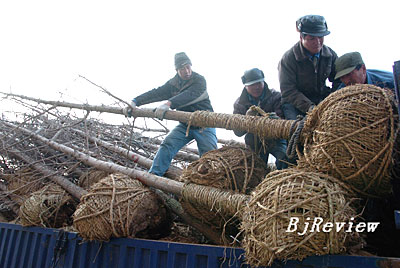| 
Is this a fluke of nature or global warming? Heavy snowstorms in January and February have some wondering. Southern China rarely sees little if any snow in winter.
"It is a sign of global warming," said Zheng Guoguang, Deputy Head of the Chinese Meteorological Society. "We expect to see more extreme weather than ever before due to the warning of the earth's surface and we should be on alert. "
International bodies have adopted two measures to address climate change. One is the direct reduction of emissions through upgrading technology and enhancing energy efficiency. The other is the indirect reduction of emissions by increasing forest coverage to absorb more carbon dioxide and reduce greenhouse gases in the atmosphere.
China has made contributions to the reduction of greenhouse gas emissions, especially through indirect reduction, though China is not obliged to cut emissions under the Kyoto Protocol, said Zhu Lieke, Deputy Director of the State Forestry Administration (SFA).
But the snow crisis, the worst in 50 years in southern China, damaged 10 percent of the country's forests, leading to huge economic losses and widespread environmental destruction. The loss of forest area because of the storms also does great damage to global efforts of easing the greenhouse effect.
Increasing forest coverage
According to Zhu, China has launched a large-scale national reforestation campaign since 1978. In November 1978, the Chinese Government decided to launch a program for building large-scale shelterbelts in northeast, north and northwest China. To now, this huge project, known as China's "Green Great Wall," stretches more than 4,480 km and is the largest ecological project in the world.
Over the past 29 years, people from all walks of life have participated in the tree-planting campaign since China set March 12 as its Arbor Day in 1979 and launched the national voluntary tree-planting campaign in the early 1980s. China takes the lead in artificial forestation in the world, with the afforested area accounting for one third of the world's total. The country has also introduced a series of laws and regulations to protect and promote the development of forests.
The Chinese Government decided to invest several hundred billion yuan in six forestry projects, including natural forest resources protection and forest rehabilitation in the decade starting in 2001.
SFA statistics show China's forestry resources have increased from 134 million hectares in 1978 to 175 million hectares at present, and its forest coverage rate rose to 18.21 percent. The Chinese Government has pledged to increase the country's forest coverage rate to 20 percent by 2010.
According to the UN Food and Agriculture Organization's report "Global Forest Resources Assessment 2005," about 50,000 square miles of forest resources were reduced worldwide between 2000 and 2005, while Asia gained 4,000 square miles during this period, with the growth mainly attributed to China's efforts.
The forest coverage growth in China has led to the constant increase in its annual carbon dioxide absorption by forests, with the amount rising from 470 million tons in 1990 to the present 500 million tons, or more than 8 percent of the country's total annual greenhouse gas emissions.
| 